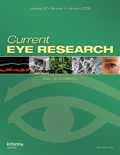
CURRENT EYE RESEARCH
Scope & Guideline
Unveiling the Science Behind Sight
Introduction
Aims and Scopes
- Ocular Biomechanics:
Research exploring the mechanical properties of ocular tissues, their role in disease progression, and implications for surgical techniques and treatments. - Retinal Diseases and Disorders:
Studies on various retinal pathologies, including age-related macular degeneration, diabetic retinopathy, and retinal vascular diseases, focusing on their pathophysiology, diagnosis, and treatment options. - Corneal Health and Diseases:
Investigations into corneal pathologies, treatment methods, and innovations in corneal surgery, including crosslinking and keratoplasty. - Innovations in Diagnostic Techniques:
Development and evaluation of advanced imaging techniques such as Optical Coherence Tomography (OCT) and their applications in diagnosing ocular diseases. - Molecular and Cellular Mechanisms in Ocular Diseases:
Research on the molecular and cellular pathways involved in ocular diseases, aiming to identify potential therapeutic targets. - Therapeutic Advances:
Exploration of new treatment modalities, including pharmacological interventions, surgical techniques, and emerging therapies for ocular diseases. - Public Health and Epidemiology in Ophthalmology:
Studies addressing the epidemiology of ocular diseases, risk factors, and health outcomes in diverse populations. - Patient-Centric Research:
Research focusing on patient-reported outcomes, quality of life, and the psychosocial aspects of ocular diseases.
Trending and Emerging
- Artificial Intelligence and Machine Learning in Ophthalmology:
There is a significant increase in studies utilizing AI and machine learning for diagnostics, treatment planning, and personalized medicine in ocular diseases, reflecting a broader trend towards technology integration in healthcare. - Regenerative Medicine and Stem Cell Therapy:
Research into regenerative medicine and stem cell applications for ocular repair and rehabilitation is gaining momentum, indicating a shift towards innovative treatment strategies. - Telemedicine and Remote Monitoring:
The rise of telemedicine in ophthalmology, especially due to the COVID-19 pandemic, has led to an increase in studies exploring remote patient monitoring and teleophthalmology practices. - Genetic and Molecular Insights into Ocular Diseases:
Emerging research focusing on the genetic underpinnings of ocular diseases is increasingly prevalent, emphasizing personalized approaches to treatment and prevention. - Integration of Patient-Reported Outcomes:
The incorporation of patient-reported outcomes and quality of life assessments in ocular research is becoming more common, highlighting the importance of patient-centered care. - Sustainability and Environmental Impact on Eye Health:
Recent studies are beginning to explore the impact of environmental factors on ocular health, including the effects of pollution and climate change, reflecting a growing awareness of global health issues. - Advanced Drug Delivery Systems:
Innovations in drug delivery mechanisms, including sustained-release formulations and targeted therapies, are trending, reflecting the need for more effective treatment modalities.
Declining or Waning
- Traditional Surgical Techniques:
There is a noticeable decrease in publications focusing on traditional surgical techniques, as the field shifts towards minimally invasive and technologically advanced methods. - Basic Science Research in Ocular Pharmacology:
Research centered solely on basic pharmacological studies without translational applications has waned, as more emphasis is placed on clinical relevance and outcomes. - Epidemiological Studies without Intervention:
There has been a decline in purely observational epidemiological studies that do not propose or test interventions, reflecting a growing preference for research that informs clinical practice. - Animal Models in Ocular Research:
The reliance on animal models for preliminary research appears to be decreasing as researchers seek more direct applications and human-based studies. - General Reviews without Novel Insights:
The publication of review articles that do not offer novel insights or updates on existing knowledge has diminished, as the journal favors original research that contributes new findings.
Similar Journals

International Journal of Retina and Vitreous
Transforming ophthalmology with open-access discoveries.The International Journal of Retina and Vitreous, published by BMC, stands as a premier open-access platform dedicated to advancing the field of ophthalmology, specifically focusing on retina and vitreous research. Established in 2015, this journal has swiftly positioned itself within the academic community, achieving a commendable Q2 category ranking in Ophthalmology for 2023, and ranks #49 out of 137 in Scopus for Medicine - Ophthalmology, indicating its growing influence and reach within the scientific landscape. The journal is committed to disseminating high-quality research, reviews, and clinical insights that explore innovations, challenges, and breakthroughs in ocular health. With the goal of fostering knowledge exchange among researchers, practitioners, and students, the International Journal of Retina and Vitreous promotes an open-access model, ensuring that vital findings are readily available to a global audience. This journal not only serves as a vital resource for advancing the understanding and treatment of retinal and vitreous diseases but also aims to inspire future studies in this critical area of eye health.
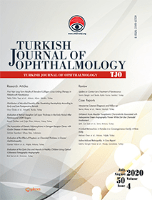
Turk Oftalmoloji Dergisi-Turkish Journal of Ophthalmology
Fostering Knowledge for Brighter VisionTurk Oftalmoloji Dergisi - Turkish Journal of Ophthalmology is a premier peer-reviewed publication dedicated to the field of ophthalmology, published by GALENOS PUBL HOUSE. Since its inception in 1997, this Open Access journal has championed the dissemination of high-quality research, fostering an inclusive environment for sharing knowledge and advancements in eye health. With an ISSN of 1300-0659 and an E-ISSN of 2147-2661, the journal serves as a vital resource for researchers, clinicians, and students interested in the latest findings and innovations in ophthalmic sciences. Although its coverage in Scopus has been discontinued since 2017, the journal has garnered a significant rank of 80 out of 114 in the field of Medicine – Ophthalmology, highlighting its relevance and impact within the discipline. Operating out of Istanbul, Turkey, the Turkish Journal of Ophthalmology continues to be a crucial platform for ophthalmologists and researchers to publish their work and advance the understanding of ocular health.

BRITISH JOURNAL OF OPHTHALMOLOGY
Exploring New Frontiers in Eye HealthThe British Journal of Ophthalmology, published by the BMJ Publishing Group, stands as a leading peer-reviewed journal in the field of ocular sciences, with a distinctive focus on advancing the understanding of vision and its impairment. With a rich history dating back to 1941, this journal serves as an essential platform for researchers, professionals, and students in ophthalmology and related disciplines. It prominently ranks in the Q1 quartile for Ophthalmology and Cellular and Molecular Neuroscience in 2023, reflecting its esteemed reputation in the scientific community. The journal boasts impressive Scopus rankings, including Rank #6 in Medicine - Ophthalmology, showcasing its influential contributions to the field. Although it does not offer open access, the journal is committed to disseminating high-quality research that informs clinical practices and enriches the understanding of sensory systems. Submissions are encouraged from all areas of ophthalmology, including clinical studies, innovative research, and systemic reviews. Join the vibrant academic dialogue by engaging with the cutting-edge findings published in the British Journal of Ophthalmology, which aims to bridge the gap between research and clinical application.
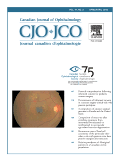
CANADIAN JOURNAL OF OPHTHALMOLOGY-JOURNAL CANADIEN D OPHTALMOLOGIE
Shaping the landscape of ophthalmology since 1966.Canadian Journal of Ophthalmology - Journal Canadien d'Ophtalmologie, published by the prestigious Canadian Ophthalmological Society, serves as a leading platform for disseminating cutting-edge research in the field of ophthalmology. With an ISSN of 0008-4182 and E-ISSN 1715-3360, the journal boasts a commendable impact factor and maintains a strong presence within the medicine and ophthalmology categories, ranking in the Q2 quartile. This journal not only provides significant insights into clinical practices and advancements but also contributes to the understanding of ocular health issues facing contemporary society. Since its inception in 1966, it has published high-quality research, making substantial strides in both practical and theoretical aspects of ophthalmology until 2024. Although it is not an open-access journal, it establishes a vital resource for researchers, professionals, and students alike, fostering an informed community dedicated to improving vision care.

KLINISCHE MONATSBLATTER FUR AUGENHEILKUNDE
Advancing the Frontiers of Ophthalmology.Klinische Monatshefte für Augenheilkunde is a distinguished peer-reviewed journal published by Georg Thieme Verlag KG, dedicated to advancing knowledge in the field of ophthalmology and general medicine. With an ISSN of 0023-2165 and an E-ISSN of 1439-3999, this journal has been a reputable platform for researchers and clinicians since its inception in 1963, continuing its impactful contributions through to 2024. Recognized in the Q3 quartile for both Medicine (miscellaneous) and Ophthalmology, this journal serves as a vital resource for those involved in ocular health, offering insights into clinical practices, recent advancements, and essential research findings. Despite its traditional publishing model, the journal retains a significant role in the academic community, as evidenced by its current Scopus ranking of #90/137 in the field of Ophthalmology. It is an essential read for professionals and students aiming to stay at the forefront of ophthalmic research and clinical innovations.
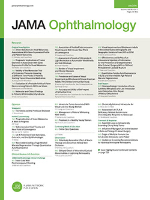
JAMA Ophthalmology
Illuminating the Path to Better VisionJAMA Ophthalmology, the premier journal in the field of ophthalmology, is published by the esteemed American Medical Association. Renowned for its rigorous peer-review process and commitment to advancing eye health research, JAMA Ophthalmology holds a prestigious position in the scientific community, boasting an impressive impact factor and ranking as Q1 in the category of Ophthalmology. With a Scopus rank of #3 out of 137 in its field and a remarkable 98th percentile, the journal serves as an invaluable resource for researchers, healthcare professionals, and students dedicated to the ophthalmic sciences. Readers can explore a wealth of cutting-edge findings, clinical studies, and review articles that not only contribute to the sustainable advancement of ophthalmic knowledge but also foster innovative approaches in patient care. As we converge into 2024, the journal continues to embrace open access principles, ensuring that groundbreaking research is readily available to a global audience, enhancing collaborative efforts and furthering the development of the ophthalmology discipline.
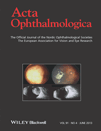
ACTA OPHTHALMOLOGICA
Leading the Charge in Vision ScienceACTA OPHTHALMOLOGICA, published by Wiley, is a premier academic journal dedicated to advancing the field of ophthalmology and related medical disciplines. Established in 1923 and maintaining esteemed status through converged years until 1994, and then from 2008 to the present, this journal has consistently delivered pioneering research, reviews, and clinical advancements essential for both practitioners and researchers in eye care. With an impressive impact factor and ranking within the top 15 of its category, ACTA OPHTHALMOLOGICA stands as a Q1 journal in both Medicine (Miscellaneous) and Ophthalmology, reflecting its significant contribution to the field. Although it is not an open-access journal, it continues to offer valuable insights and empirical findings that inform clinical practices and innovative research approaches. As such, it remains a vital resource for scholars, clinicians, and students keen to stay at the forefront of ophthalmological science.
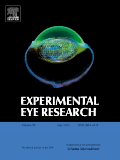
EXPERIMENTAL EYE RESEARCH
Advancing Vision Science Through Innovative ResearchEXPERIMENTAL EYE RESEARCH, published by Academic Press Ltd - Elsevier Science Ltd, is a preeminent journal dedicated to advancing the fields of ophthalmology and neuroscience. With a history of insightful publications dating back to 1961, this journal serves as a critical platform for researchers, professionals, and students interested in the cellular and molecular mechanisms underlying visual processes. The journal boasts impressive rankings, including being placed in the top quartile (Q1) of both the Ophthalmology and Sensory Systems categories, and is recognized in the 2nd quartile (Q2) for Cellular and Molecular Neuroscience. With an impact factor reflecting its significant contribution to the field, EXPERIMENTAL EYE RESEARCH is a valuable resource that promotes the exchange of innovative research and ideas essential for understanding the complexities of eye function and vision-related disorders. Researchers looking to publish their findings or stay abreast of the latest studies will find this journal a vital component of their academic toolkit.
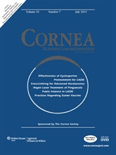
CORNEA
Exploring the frontiers of corneal research and innovation.CORNEA is a prestigious peer-reviewed journal published by Lippincott Williams & Wilkins, focusing on the rapidly advancing field of ophthalmology with a particular emphasis on corneal research and diseases. With an impact factor categorized in the prestigious Q1 quartile for its discipline, CORNEA has established itself as a leading platform for the dissemination of both fundamental and clinical studies since its inception in 1982. The journal is ranked 25th out of 137 in the Scopus Medicine-Ophthalmology category, placing it in the 82nd percentile among its peers, which underscores its vital role in influencing ocular research and clinical practices. While the journal is not currently open access, it provides valuable insights and updates for professionals, researchers, and students working to advance knowledge in corneal health, contributing significantly to the ongoing dialogue in the ophthalmological community. With a commitment to excellence, CORNEA continues to publish high-quality research and reviews in its pursuit to improve ocular outcomes and patient care.

Augenheilkunde Up2date
Navigating the Future of Ophthalmic Research.Augenheilkunde Up2date is a pivotal journal in the field of ophthalmology, published by GEORG THIEME VERLAG KG, a renowned publisher known for its commitment to advancing medical knowledge. With its ISSN 1616-9719 and E-ISSN 1616-9735, this journal serves as a vital resource for researchers, professionals, and students interested in the latest developments and nuanced discussions in eye health. Although not available as open access, its curated content offers significant insights into contemporary research, clinical practices, and emerging trends in ophthalmology, thus promoting the continuous professional development of its readers. There is an emphasis on providing comprehensive reviews that encapsulate the pertinent advancements in the field, making it an essential publication for those aiming to enhance their expertise in eye care and vision science.